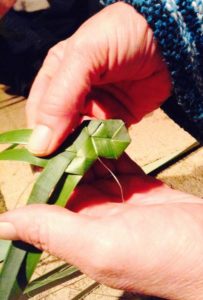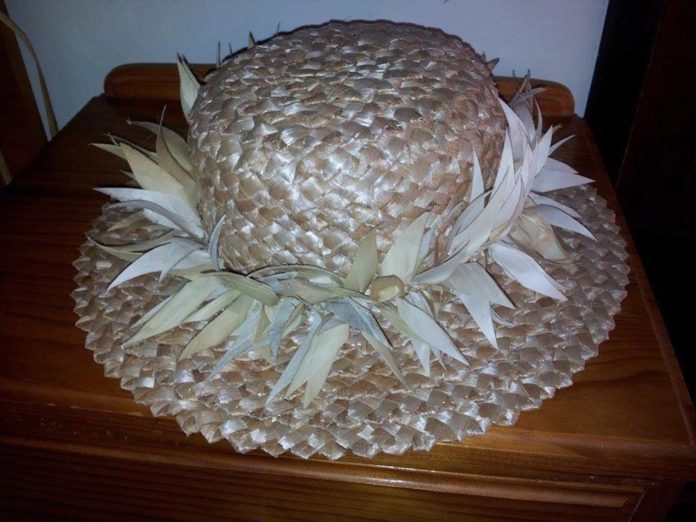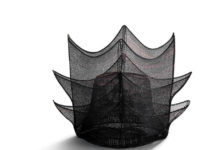The Bounty hat is from Norfolk Island. The method for making the hat has been handed down through the generations on Norfolk Island since 1856 when the Pitcairn Islanders arrived and made the island their home. The Pitcairn Islanders inherited the technique from their Polynesian foremothers (who were originally from the islands of Tahiti, Huahine and Tubuai in French Polynesia), who settled on Pitcairn Island in 1790 with nine of the mutineers of the Bounty, and six Polynesian men.
 The fibres used for the Bounty hats are mostly locally sourced and include mu’u (the Norfolk “flax” with razor sharp edges gathered from around the cliffs), korn has (corn husk from gardens), rahulu (banana bark), drienflaegs (drain/water flax gathered from freshwater creeks), kentia palm fronds, and maunten rash (mountain rush). Imported fibres include priori (pandanus) from islands such as Pitcairn, Tahiti and Tonga. The creation of the hat begins with the plaiting of four lengths of fibre in either a zigzag (sometimes called the “Norfolk plait”) or straight edged design; while another design is known as the “Heritage plait”, created from six strands. The plait is then sown, row upon row, and shaped from the crown to the brim.
The fibres used for the Bounty hats are mostly locally sourced and include mu’u (the Norfolk “flax” with razor sharp edges gathered from around the cliffs), korn has (corn husk from gardens), rahulu (banana bark), drienflaegs (drain/water flax gathered from freshwater creeks), kentia palm fronds, and maunten rash (mountain rush). Imported fibres include priori (pandanus) from islands such as Pitcairn, Tahiti and Tonga. The creation of the hat begins with the plaiting of four lengths of fibre in either a zigzag (sometimes called the “Norfolk plait”) or straight edged design; while another design is known as the “Heritage plait”, created from six strands. The plait is then sown, row upon row, and shaped from the crown to the brim.
These hats are worn day to day and are also a defining feature during the Bounty Day celebrations on the 8th of June every year, where families proudly wear their hats (often made by themselves, a relative, or their favourite artist) and period clothing, and re-enact the arrival of their forebears.
Well-loved weavers of the past included Aunt Ag, Aunt Estell, Mary Jo, Beattie Bigg, as well as Dianne Buffett who recorded the techniques in her book Plaiting in Paradise. Today the elders of plaiting and weaving are Edie Christian, Maeve Hitch and Joy Cochrane, while a generation of younger men and women have taken up the craft, resourcefully creating their own styles using traditional and new materials, and who also teach young school children the skill in order to connect them to their heritage.
Further reading
Buffett, Alice Inez, Speak Norfolk Today: An encyclopaedia of the Norfolk Island language, Norfolk Island, Himii Publishing, 1999.
Buffett, Dianne, Plaiting in Paradise: A guide to the traditional Norfolk Island art of plaiting, Norfolk Island, Twentytwenty, 2006.
Norfolk Island Museum, Collections: NI Museum Trust, http://norfolkislandmuseum.com.au/collections/norfolk-island-museum-trust/, accessed 13 February 2016.
Sampson, Margarita, ‘Dar Plait fe Ucklun – An Installation of Norfolk Island Weaving’, at Craft Victoria and Norfolk Island Museum, 2006.






[…] Upstairs the displays continue to highlight aspects of Norfolk’s history and culture such as Anniversary (or Bounty Day), Melanesian Mission, Religion, Domestic Life, Industry and Agriculture, Whaling, Tourism and Education. Artefacts on display include historical weavings, items from the Melanesian Mission and whaling implements. There is also a display of Bounty Hats (below right), exclusive to Norfolk Island, and you can read the history of the hats here […]
Great information for someone so far away from Pitcairn and Norfolk…I love this story of Mutiny on the Bounty…
It’s sad and thought provoking..to know that people survived so isolated is a testament to who they are.. people that I admire. I love the arts still practiced there…Pitcairn is on my bucket list…
About ya been..is where I’ll find ya!
God Bless.